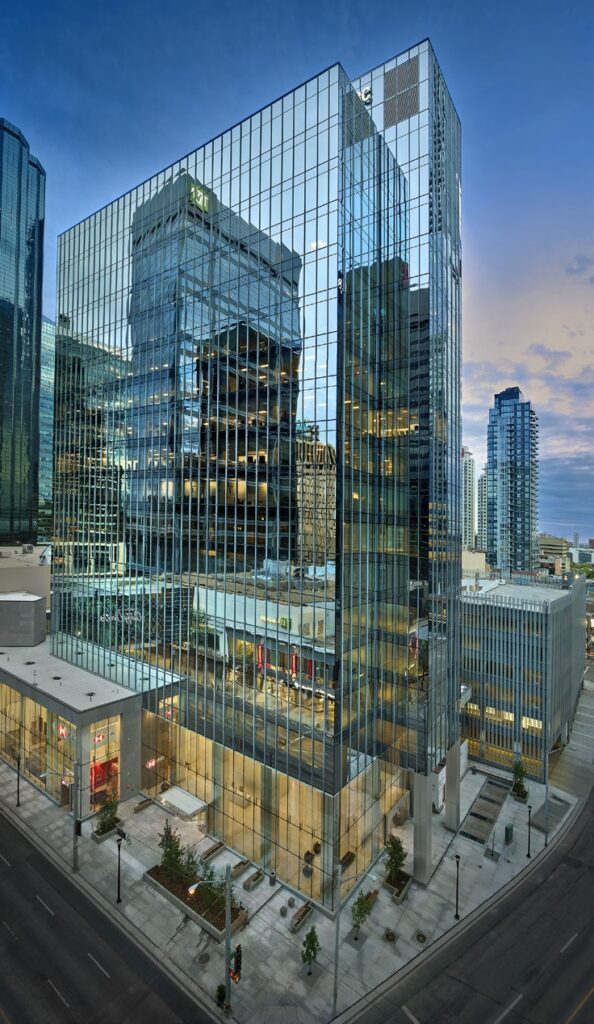How the EcoStruxureTM Building Operation platform improves building systems, management, and the workplace experience
When the Alberta Investment Management Corporation (AIMCo) took ownership of Edmonton’s HSBC Place, the building’s primary appeal to tenants was its central location and connection to the Edmonton City Centre. Built in the 1980s, the 18-story structure had an atypical floor plan, limited tenant amenities, and building systems that required upgrading.

“The mechanical and electrical equipment had reached the end of its useful life,” says Kevin Humphrys, Vice President of Real Estate Management at Epic Investment Services, the building managers. Epic brought together a team that included building integration specialist Automatic Controls Ltd. to implement the control systems.
“Before the revitalization started, the control systems were mostly original pneumatics, with gigantic compressors moving air to actuate motors and valves,” explains Jeremy Leahy, President of Automatic Controls. “The dashboard was essentially dials and on-off buttons, and it didn’t allow any effective zone control for heat and ventilation.”
Then, the project’s scope expanded from controls for the mechanical systems to an integrated dashboard system that included lighting, access control, video, and power management.
“That’s when it became really interesting,” Leahy says. The team began collaborating closely with Schneider Electric to design the building system integration using the EcoStruxure Building Operation (EBO) platform.
“Each part of this integration was unique,” says Leahy. “Schneider Electric brought a depth of knowledge and resources, which helped us consult the right specialists for each challenge. With any equipment that gets connected to a building control system, we need to know how it works inside and out. Access to experts in North America and Europe, all part of the Schneider team, was an essential resource.”
EcoStruxure Building Operation allows building managers—whether on-site or remote—to monitor, measure, and optimize a building’s performance and energy usage. As a vendor-agnostic solution, EcoStruxure Building Operation can link systems that otherwise don’t interact.
A typical integration combines data and controls for energy use, lighting, fire safety, and HVAC. In HSBC Place, the dashboard included the fire alarm panel via Modbus connection, tie-ins to the generator system, automatic transfer switches, and the main UPS system via SNMP—along with the use of BACnet connections, API protocols, plus Web Services to display information from building security in the dashboard.
It’s a challenge to get all those disparate systems to talk to each other, but the benefits are significant.
Conventional building management systems provide limited feedback, at one point in time, while EcoStruxure Building Operation looks for patterns and trends in the building data. Leahy gives the example of a sensor showing a component being hotter than usual. A conventional system only tells managers that something is wrong; a system like EcoStruxure Building Operation layers information from other equipment, collected in real-time, to help pinpoint the underlying cause. This data analysis capability translates to cost and energy savings for building managers.
The tangible benefits extend to the people using the building, who experience a much more comfortable workspace, says Leahy. “The fine-tuning we can achieve in HSBC Place goes beyond floor or even zone control; all the rooms, down to each fan coil unit, can be individually monitored and adjusted. A conference room, for example, can get extra air circulation during a meeting, while the unoccupied office next door stays at a baseline ventilation.”
In HSBC Place, the EcoStruxure Building Operation platform is one component of a very successful revitalization. Schneider Electric’s end-to-end solution allows the building managers to pull real-time data from multiple areas and make better, faster decisions to improve comfort, safety, sustainability, and cost savings. HSBC Place went from a Class C office building to a top-rated class AA, designed to LEED Gold standards, and achieving WELL Core Certification at the Gold Level.
“The feedback has been great, and HSBC Place is boosting its occupancy, even though the project finished mid-COVID. Now, we’re often back there to do new-tenant setups,” Leahy says. “I’m really proud of what we did. We proved it’s possible to integrate virtually anything.”
For more on how HSBC Place implemented EcoStruxure Building Operation, download our customer case study.
About the author

Devin Sikorski, Business Development Manager – Building Automation
Devin Sikorski is the Business Development Manager for the Building Automation segment for Schneider Electric Canada. As an experienced Business Development Manager with a demonstrated history of working in the building automation industry, he drives the growth and development of Schneider Electric’s partners to best serve and support their clients. Devin is skilled in Building Management Systems, Commissioning, BMS Analytics, and Sales and Account Management.



